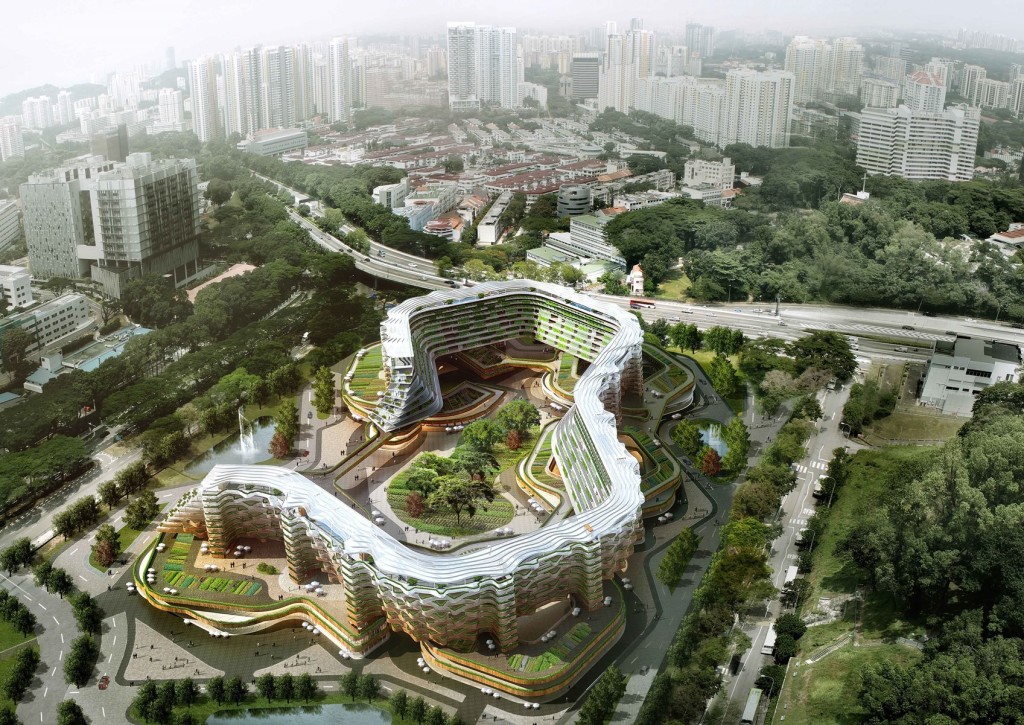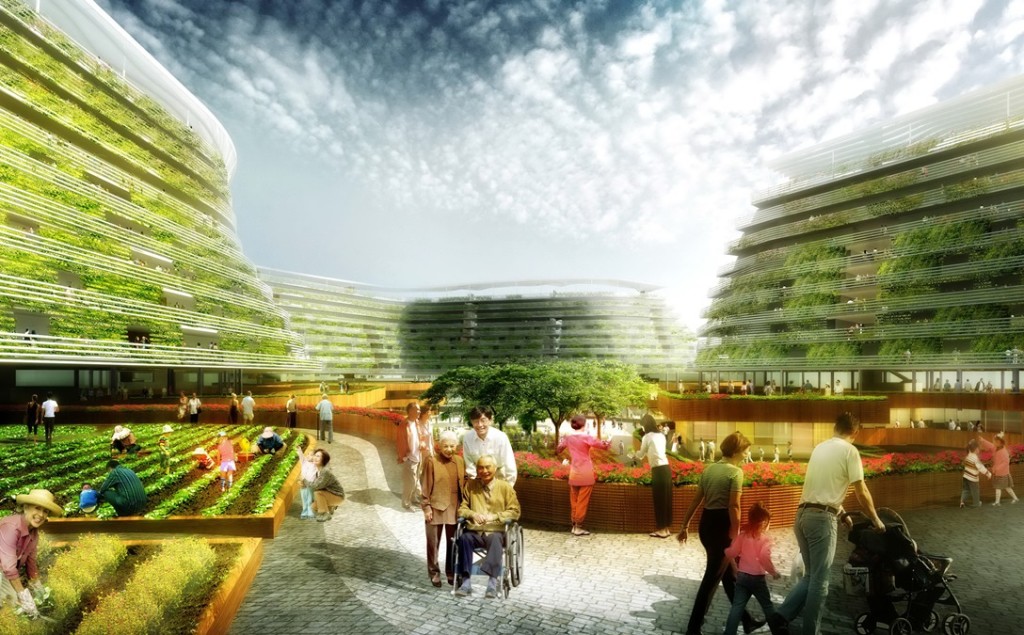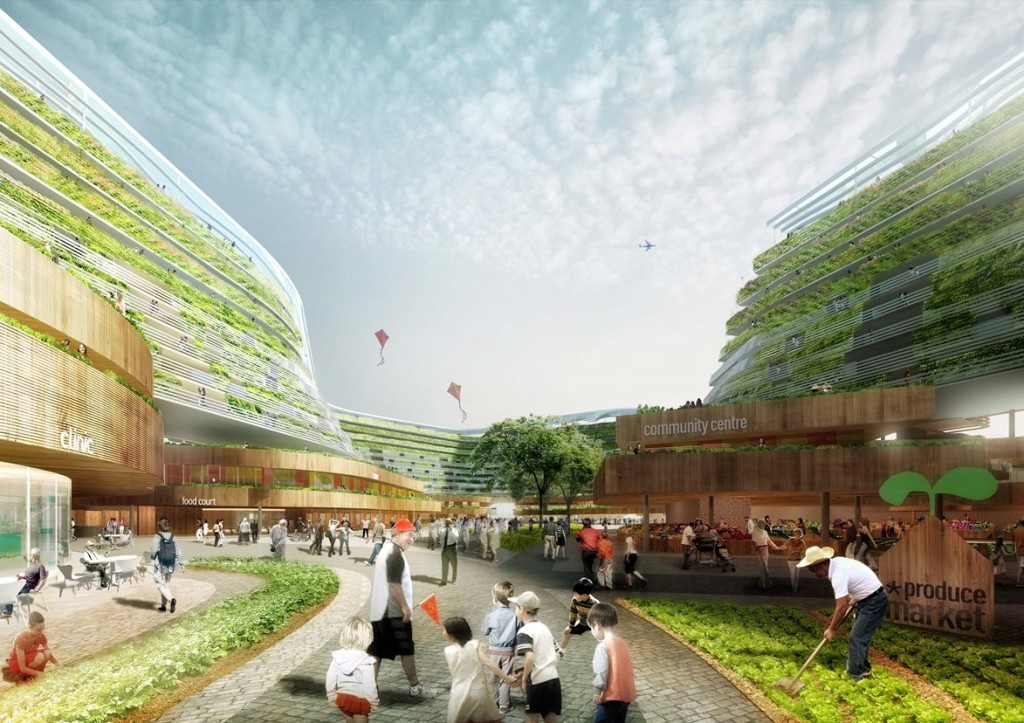Imagine a beautiful and environmentally friendly complex where seniors can retire in communal bliss. One where they can stay active growing their own vegetables, make some money, and live in lush green comfort. In other words, a pristine development which looks like the visual above (courtesy of SPARK).
Sounds like a green paradise in land-locked Singapore? Not if SPARK architects can help it.
Unveiling their concept for Homefarm – an integrated vertical urban farming and retirement living facility – SPARK shared their dream design of such a property.
Singapore’s Ageing Population and Food Challenges
Speaking at a media event for Homefarm, SPARK Director Stephen Pimbley shared how Singapore’s rapidly ageing population and need for a secure food supply could be mitigated by innovative living concepts that married the two.
By 2030, one in five Singapore residents will be aged 65 years and older (an increase of 6 per cent in 2990). These demographic changes will impose a significant strain on our social, economic and infrastructural systems. With far fewer younger working Singaporeans to support them, coupled with longer life spans, active agers of the future will need to be more self sufficient and to stay healthy well into their golden years.
The other challenge of securing a stable food supply is one that many rapidly urbanising Asian nations face. Importing over 90 per cent of our food, a tiny island nation like Singapore would face acute food pressures. This makes it important for us to diversify food sources and boost local production through agricultural technology and innovation.
Homefarm – an Integrated Farming, Living and Working Retirement Community

Designed with aesthetically pleasing curvilinear terraced lines reminiscent of rice terraces in Bali, Homefarm occupies an approximate 15,000 square metres in area. It seeks to achieve the following multiple sustainable benefits in a rapidly ageing population:
- Environmental benefits through use of green designs and technologies which reduces the energy footprint;
- Economic benefits through providing meaningful jobs (estimated 400 part-time roles) for residents such as planting, packaging, guiding, and shop keeping;
- Health benefits for active agers through urban farming and activity corners for exercise and relaxation;
- Social benefits through creating a conducive environment for beneficial interaction and community building; and
- Food security benefits by making use of agricultural systems that generate high yields in an urban farm.
Through creating a green living environment inspired by the legendary Hanging Gardens of Babylon, SPARK explained that various urban farming technologies could help ensure higher yields for the limited spaces in Singapore. They are:
- Vertical aquaponic farms on the walls which not only produce green leafy vegetables but help provide a solar buffer/shade to living spaces;
- Soil-based linear farms which line the corridors of the complex; and
- Traditional soil-based farms on the ground floor areas.
Through vertical aquaponic farming and rooftop soil plantings, Home Farm was projected to yield about 35 tonnes of green leafy vegetables every year. This could achieve a sales of about S$6 million an annum. The income generated could help supplement the living costs of active agers who may no longer have other sustainable sources of income.
Living Facilities and Environmental Management in Home Farm

Beyond encouraging active agers to stay financially active and productive through sustainable farming, Homefarm would also have a complete range of facilities and amenities. This would include the following:
- Central plaza and green living spaces for communal activities and inter-generational bonding;
- Food court/ social centre for meals between family members and friends;
- Organic supermarket;
- Fresh produce market (like a farmer’s market) which comprises harvested vegetables for sale;
- Kindergarten and library;
- Seniors’ Mall;
- Packaging workshops (for the fresh produce to be processed before selling); and
- Health Centre.
Built in a modular fashion, Home Farm’s design allows it to be easily customised for any shape or area. Pollution is kept minimal with an envisaged 25% of biomass recycled internally to help provide fertiliser for the vegetable farms on site.
Water could also be recycled on Home Farm, with rain water collected and distributed to help water the vegetables on a regular basis. In addition, waste management systems could be designed such that there is minimal wastage and maximum recycling.
Q&A With Home Farm Creator Stephen Pimbley
To find out more about Homefarm, I have reproduced below a selected series of Q&As with SPARK Director Stephen Pimbley. Here, he explains his vision for Homefarm and its socially and environmentally sustainable typology.
Housing for seniors and urban farming are not typically combined. What was the spark that led to the idea of merging them into a new type of residential infrastructure?
It is always difficult to put your finger on the genus of an idea, but in this instance it was my search for answers to questions that I had failed miserably to respond to in two separate television interviews. I was asked what I thought about the apparent increase in urban farming activity and the problem of ageing in association with city densification. I was so frustrated with myself that I decided to do my own research. Home Farm emerged from the impetus to improve my general ability as an architect to respond to pertinent social issues, rather than just putting my head in the sand and leaving the obvious problems we face as a society to be solved by
someone else.
What do you perceive to be the main shortcomings of existing housing for seniors in Singapore and elsewhere?
My experience of senior care is restricted to visiting relatives in care, which was pretty grim and terribly sad. I remember a feeling of total powerlessness to do anything to help a grandmother who I loved dearly. This was a long time ago, but perhaps we still do not treat the seniors in our society with the respect they deserve. I feel that this is especially true in a country like Singapore, whose current generation of seniors dragged the country out of the colonial Third World mire to the wealthy First World status it now enjoys.
Why should seniors live in isolated ghettos where self-esteem is all but lost? Homefarm seeks an alternative proposition that encourages participation and engagement in a safe and secure environment. In my view, the paradigm of elderly care needs a good kick in the bottom. We can do and should be doing better to reinvent the typology.
What was the thinking behind the building’s form? What are some of the architectural precedents you looked to and why?
I am interested in the relationship between design and identity, and I enjoy the Singaporean architecture of the late 1960s and early ’70s – a time when Singapore’s architects and designers celebrated the release from the shackles of imperialism and, perhaps more importantly, the break in 1965 from the Malaysian Federation. Singaporean architects of the time were heavily influenced by British Brutalism and Japanese Metabolism. Both styles encapsulated the post-Second World War spirit of embracing the future, albeit imbued with a social conscience.
Extraordinary buildings were produced in Singapore during this period such as Pearl Bank Apartments, People’s Park Complex and the Golden Mile Complex. This was also the nascent period of the Government’s Housing and Development Board (HDB) programme. Since this key period of nation building, it seems that residential architecture has rather lost its way save for a few notable examples such as Paul Rudolph’s Colonnade. As Singapore begins to celebrate its fiftieth year of independence, Home Farm attempts, in the manner of James Stirling’s Florey Building, to return to a more robust modular architecture that is redolent of the national spirit of the ’60s and ’70s. Home Farm has an open courtyard protected by the sweeping arms of the housing, which facilitates enclosure and engagement as
well as urban links with the surrounding area.
What influenced your decision to use the aquaponic system as opposed to some other type of agri-tech system?
The whole life cycle of the aquaponic system sits seamlessly with the ethos of Home Farm. The 360-degree nutrient-enriched water story is historic passive technology reinvented and transferred into the twenty-first century to facilitate lightweight high-volume vertical farming. In a country where land is at a premium because of massive urbanistation, aquaponic farming is perhaps the most appropriate and sustainable model.
What would it be like to live in Home Farm? What unique atmospheric and programmatic qualities would the apartments offer?
Home Farm is not a forced seniors’ labour camp. Not all residents would be expected to engage with the farming activities. We are simply presenting the opportunity for part-time work, should it be desired, to assist with income support and social engagement. The intention is to provide a different sort of environment capturing what is best from the micro-urban ideas of HDB developments – the great social spaces, the streets and courtyards in the sky, and the ‘void decks’ – and to combine these with green facades that are not superficially panted for effect but have a economic and social imperative.
Home Farm life is a far cry from the typical dense Asian housing developments. It is a reflection on a different development pattern, a lower development density, and a
more dispersed and open environment. The feeling of space in a very green and active park will create an extraordinary atmosphere and environment – a new
model of development that celebrates all that is best about Singapore and its ambition to become a city in a garden.
Which segment of the housing market (on the scale from affordable to exclusive) would Home Farm serve and why?
The current Singaporean senior generation, the nation builders, are perhaps those most exposed and economically vulnerable. The members of the current baby boomer generation, which is now entering the senior arena, are generally more affluent than their parents and grandparents. Home Farm seeks to support those at risk bringing them into a socially sustainable environment that has a mixture of income types and family groupings rather than a ‘mono cultural’ section of society.
How would Home Farm perform in terms of sustainability?
The socially sustainable aspects of Home Farm are as important, if not more important than the environmental concerns, although the latter are perhaps easier and more fashionable to discuss and implement. Nevertheless, we envisage Home Farm as a development that surpasses all current Green Mark requirements and Government city greening ambitions to create a development that sets a global precedent. The building’s environmental life cycle has been well considered, including the use of waste bi-product from the farming activity to power a bio-mass power plant that in effect creates free energy for the public areas of the development.
The programme mix for the common areas is rich, incorporating a range of components – from a produce market to a medical centre to a kindergarten. Why such a mixture?
In essence we have tried to encapsulate the requirements of the Home Farm community and capture other components and facilities that provide a public face or an engagement with the wider community. Home Farm is not an island development. Critical to its success will be its relationship with the city, and its ability to draw visitors, shoppers and diners into its public garden interior.
What is the key message of Home Farm?
Home Farm promotes social inclusion, which we believe has a strong influence on health and wellbeing. The inclusive philosophy of Home Farm and the improved economic opportunities it facilitates should bring health benefits and self-esteem to society’s less favoured and marginalised individuals.



Hi,
This sounds great! I am the author of several, internationally sold backyard farming books and will soon have a TV show on Sustainable Living. I will also be opening a small space, micro urban farming facility in the Florida Keys. I would be very interested in becoming a part of this project, should you be looking for consultants. (I have also taught various workshops for 25+ years and would be able to assist you in creating related educational programs for the residents and staff.)
Please feel free to contact me!
Thank You
Kim